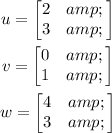Given: The vectors u, v, and w as-

Required: To determine the value of c such that u+cw is orthogonal to u.
Step-by-step explanation: Two vectors are said to be orthogonal if their dot product is zero.
The vector u+cw is-

The dot product of two vectors of the form-
Now, taking the dot product of (u+cw) with u as follows-

Now, the product will be zero if the vectors are orthogonal.

Final Answer: The value of c is-
